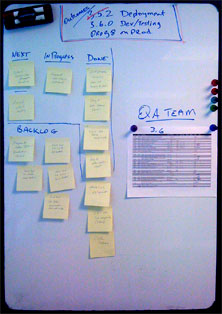Several weeks back I wrote about posting medium-term priorities at the top of my whiteboard as a way to keep from getting sidetracked. The three stories that I’m working on completing by the end of the week, the three outcomes I’m expecting (or expected) to produce. That continues to work well, though it might be better if my desk & cube walls were configured differently so that the whiteboard was in front of me instead of behind and off to a side.
The situation still arises, though, where there are many tasks to be done that all fit within those three main stories. It’s real easy, when faced with a mountain of tasks, to try to attack them all at once. “I can get a little of this one done, then a little of that one,” the thinking goes, “and hey that third one is important too so I should work some on that one so I can talk about it at tomorrow morning’s stand-up meeting.”
Bad idea. More and more, we’re hearing that multitasking doesn’t work, and I agree. Even when we think we’re getting several things done in a day, we’re not doing any of them as well as we could. The little task-switches are leeching brain-power and and we don’t even realize it.
So how can we reduce multitasking? That’s simple – just don’t do more than one thing at a time.
OK, so it’s not really that simple, but in a way it is. Pick one thing and work on it to completion, or at least to a reasonable stopping point.
How? Back to the whiteboard.  I still have my priorities at the top, but now I’ve started putting every task needed to fulfill those priorities on a “yellow sticky” (the generic term for 3M Post-It Notes and clones thereof). There are also three columns, a little hard to see in the photo – “Next,” “In Progress,” and “Done.” Under the “Next” column is a section I’ve called “Backlog,” which is for anything not yet in the other three columns. Now, here’s the magic part – the “Next” and “In Progress” columns cannot have more than two items in them. Can’t. It’s a rule, and I don’t break it.
I still have my priorities at the top, but now I’ve started putting every task needed to fulfill those priorities on a “yellow sticky” (the generic term for 3M Post-It Notes and clones thereof). There are also three columns, a little hard to see in the photo – “Next,” “In Progress,” and “Done.” Under the “Next” column is a section I’ve called “Backlog,” which is for anything not yet in the other three columns. Now, here’s the magic part – the “Next” and “In Progress” columns cannot have more than two items in them. Can’t. It’s a rule, and I don’t break it.
I know, I know – allowing two items to be “In Progress” at the same time still implies multitasking, but in my business I know that I can’t really work on something straight through. I need to get information from someone who’s at lunch, a database task takes 20 minutes to run, that sort of thing. So I allow myself to have two tasks “live” at any time, but there’s really only one that I’m actively working on at any given point.
If When someone brings me another task, or one pops into my head, I take 5 seconds to write it on one of those magic stickies and put it on the board. Five seconds, no more, then I’m back to work. Why take the time to write it down? That’s a bit part of David Allen’s Getting Things Done – don’t make your brain keep all the little bits of “I have to do this later” thoughts, put them on paper and let your brain get back to working on what’s important.
Back to the whiteboard. When a task is done, it goes to the “Done” column and I re-evaluate the tasks in “Next” and “Backlog” with regard to my overall priorities. It’s a really simple way of keeping things straight and getting things done without all the frustration and wheel-spinning. Now, I know that you think I’m some sort of genius for having come up with this, but that’s not the case. Kanban is a scheduling system that comes from the smart folks at Toyota. you might want to browse through this personal kanban site for more info on a less corporate, factory-line take on it. There’s also this book, which I’ve not read (yet) but has good reviews.
Give it a shot — it doesn’t take a lot of setup or cost and it’s reasonably easy to implement; you just have to set some limits and then do your best to stick to them.
There is, of course, still the question of how to get that one thing done. I’ll write more about that in an upcoming post. In the meantime, have a tomato.
[note: I never did get around to that third post. Ironic, isn’t it? Anyway, take a look over at this post on the Trello Blog, it says everything I was thinking of writing.]
Great post, Steven! Thanks for posting the pic in particular — I personally love seeing real-world task management examples. : )
re: Multitasking… in some ways, we are are ALWAYS multitasking. What sets apart good vs. bad, I think, is primarily the frequency of task-switching, and how long + deep one stays focused on a single task. Granularity, and Depth, if you will.
A related link you might find interesting: Synergistic Oscillation — http://www.braindance.com/5mmap.htm